-
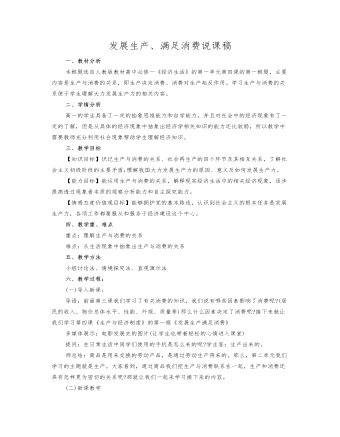
人教版高中政治必修1发展生产-满足消费说课稿
(2)多媒体展示:消费者们反映iPhone4的500万像素太不给力,3,5英寸的屏幕太小,促使苹果公司给新一代iPhone装上了一颗800万像素的摄像头4,0英寸的屏幕等,发展到最新的一代iPhone6plus已经达到5.5英寸。师:新一代iphone更新的驱动力是什么呢?其实新产品的升级对于苹果公司来说经费投入不小但是不经过升级换代产品就不能满足消费者的新的消费要求,所以消费者的反应客观上促进了iphone的升级换代——消费对生产的调整与升级起着导向作用(3)多媒体展示:随着网购迅猛的发展,快递、仓储业务等也出现爆发式增长。这一现象说明了什么?(举例:iPhone在全球市场的火热,“壳”文化产业第一个进入人们的视线,随着时间的发展,外壳的产业飞速蓬勃的发展着)结论:一个新的消费热点的出现往往能带动一个或多个产业的出现和成长。消费所形成的新的需求对生产的调整和升级起着导向作用,需求的数量和质量调节供给的数量和质量。
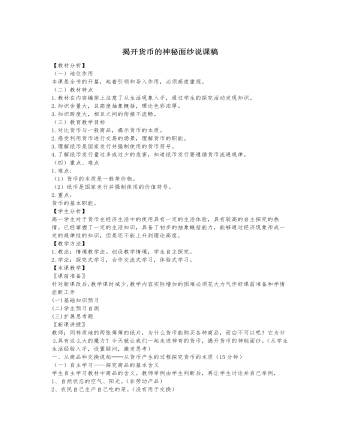
人教版高中政治必修1揭开货币的神秘面纱说课稿
(二)剖析案例,探究“法币”贬值的原因及危害──探究纸币发行量1935年,国民政府推行“法币改革”,宣布以中央、中国、交通银行发行的纸币为“法币”。从1937年6月至1948年8月21日法币崩溃为止,法币发行量上升到四十七万倍。最初的100元法币可以买两头牛,到了1949年五月仅可以买到一粒大米的2.45%。“大街过三道,物价跳三跳”。由于物价疯狂上涨造成的恐慌心理驱使,人们疯狂地抢购各种物资。思考讨论:1、100元法币最初能买两头牛,最后只能买到三粒大米,为什么会产生这种经济现象?这种现象有哪些危害?2、如果纸币发行过少行不行,为什么?3、纸币发行量怎样就比较适当?流通中实际所需要的货币量受哪些因素的影响?在师生交流讨论中,最终由学生得出结论:纸币发行的如果过多,就会导致物价上涨,影响人民的生活和社会经济秩序;如果过少,就会导致商品销售困难,商品流通受阻。因此,国家不能任意发行纸币,必须与流通中所需要的货币量相等。(三)辨识社会现象──规范人民币的使用
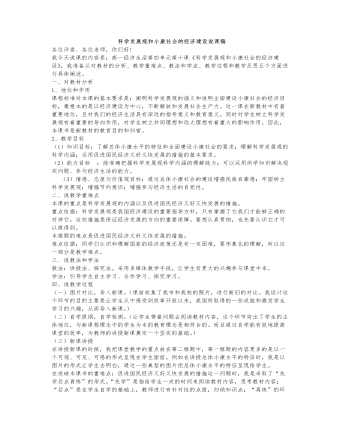
人教版高中政治必修1科学发展观和小康社会的经济建设说课稿
一、对教材分析1、地位和作用课程标准对本课的基本要求是:阐明科学发展观的涵义和说明全面建设小康社会的经济目标,最根本的是以经济建设为中心,不断解放和发展社会生产力。这一课在新教材中有着重要地位,且对我们的经济生活具有深远的指导意义和教育意义。同时对学生树立科学发展观有着重要的导向作用,对学生树立共同理想和远大理想有着重大的影响作用。因此,本课书是新教材的教育目的和归宿。2、教学目标(1)知识目标:了解总体小康水平的特征和全面建设小康社会的要求;理解科学发展观的科学内涵;运用促进国民经济又好又快发展的措施的基本要求。(2)能力目标 :能准确把握科学发展观科学内涵的理解能力;可以运用所学知识解决现实问题、参与经济生活的能力。(3)情感、态度与价值观目标:通过总体小康社会的建设增强民族自豪感;牢固树立科学发展观;增强节约意识;增强参与经济生活的自觉性。
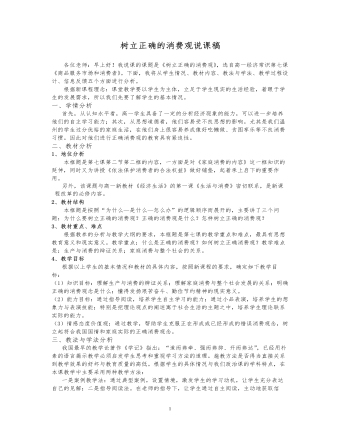
人教版高中政治必修1树立正确的消费观说课稿
(三)师生互动、巩固知识、课堂小结为培养学生的抽象思维能力和独立思考的能力,课堂小结让学生来总结,教师要向学生提示本课题主要讲了几个问题。并推荐一位擅长书法的同学书写。一方面可以展现该同学的书法技能,发挥其特长;另一方面对于其他同学也起到了模范带头的作用。(四)板书设计:板书设计准备采用条目式板书,条目式板书的作用是条理清楚、简练,一目了然,并且能够为学生做笔记乃至以后的复习提供方便。二、树立正确的消费观1、为什么要树立正确的消费观?(1)理论依据:生产与消费的辩证关系;(2)现实分析:关系到社会的整体利益;(五)课后作业注意观察自己的家庭消费情况,记录某时期的家庭各项消费支出,根据所学理论,判断自己家庭的消费结构是否合理。这有利于形成学生观察生活和观察身边的经济现象的习惯,培养思维能力和理财能力。又可以增强政治课的兴趣。
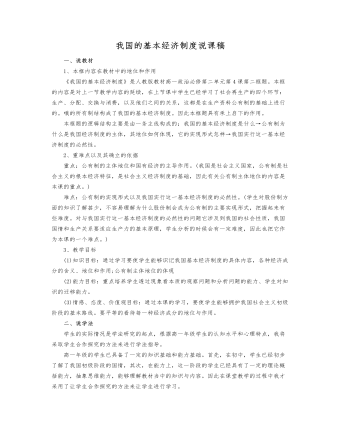
人教版高中政治必修1我国的基本经济制度说课稿
5、课堂小结利用多媒体和板书展现本节课的纲要,并指出重点和难点。设计意图:不仅使学生将所学的知识相互连接形成知识网络,而且进一步强化对重点知识的认识,有利于学生对知识的理解和掌握,并有利于学生在课后对所学知识进行有针对性的复习。6、课堂练习利用多媒体展示由易到难的练习。设计意图:巩固所学知识并把它转化为读题解题的能力,在练习中能满足不同层次学生的需要,使各类学生都能获得成功感,培养学习本学科的兴趣。7、课后探究联系国家鼓励青年人自主创业的时政热点,让学生课后查阅青年学生创业基金的实施项目,鼓励学生将来进行自主创业。设计意图:巩固所学知识,并能运用到现实生活中去。树立学生的创业意识。五、小结本课教学主要突出以下几个特点:1、重学生:以学生发展为本,确定学生在教学中的主体地位贯彻“以人为本”的原则,充分发挥学生在学习中的主动性、积极性和创造性。
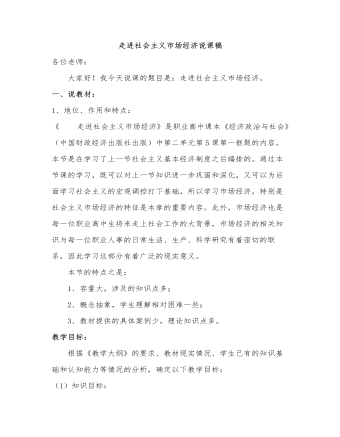
人教版高中政治必修1走进社会主义市场经济说课稿
四、教学过程:(一)、课题引入:教师创设问题情景(创设情景:使用多媒体模拟一些比较有趣、与生活实践比较有关的事,并提出问题。)激发学生的探究欲望,引导学生提出接下去要研究的问题。(二)、新课教学:1、针对上面提出的问题,安排学生分组讨论,让学生通合作学习探索有关的知识,并进一步引出下面要解决的问题。2、组织学生进行新问题的探究学习,设计上最好是有对比性、通过多媒体的辅助,由学生分析比较,归纳总结出知识的结构。(三)、实施反馈:1、设计相关习题达到对学过的知识的检测和巩固;2、课堂反馈,迁移知识(最好迁移到与生活有关的例子)。让学生分析有关的问题,实现知识的升华、实现学生的再次创新。五、板书设计:在教学中我把黑板分为两大部分,左边是第一部分,各知识点罗列其下,第二部分写在右边,各知识点罗列其下。
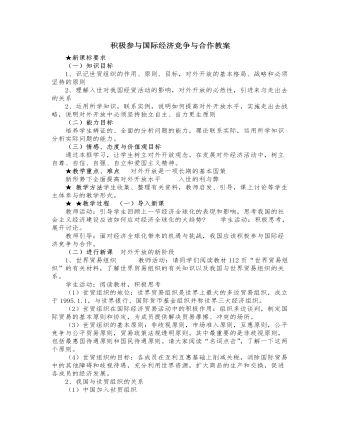
人教版高中政治必修1积极参与国际经济竞争与合作教案
学生活动:认真阅读,积极思考。教师总结:这样一个人口大国,依靠外国是不能解决温饱问题的,更谈不上社会主义现代化。实行对外开放,发展对外经济关系,必须坚持独立自主、自力更生原则,并以此为自己发展的根本基点。但坚持坚持独立自主、自力更生,并不是闭关自守、盲目排外,而是在立足自身基础上实行对外开放,把二者结合起来。(三)课堂总结、点评这节课我们重点学习了我国对外开放方面的有关知识,知道了在经济全球化的国际大趋势下,社会主义现代化建设必须实行对外开放,积极参与国际经济竞争与合作。了解了我国对外开放的成就、格局、新形势下的基本政策和战略。这对于我们在正确地认识国际经济关系,增强社会主义优越感和民族自强意识,自觉投身现代化建设等将有重大指导作用。

人教版高中政治必修1储蓄存款和商业银行教案
第三、结算业务结算业务时商业银行为社会经济活动中的货币收支提供手段与工具的服务。银行从中收取一定的服务费用。除上述三大业务外,商业银行还可以提供债券买卖与兑付、代理买卖外汇、代理保险、提供保管箱等其他服务。教师活动:商业银行在我国经济建设中具有巨大作用。请同学们看教材52页专家点评。学生活动:阅读课本,认真总结,得出结论(三)课堂总结、点评 这节课我们重点学习了储蓄存款和商业银行的有关知识,知道了储蓄存款活动程序、主要机构、特点和利息的计算等常识,了解了各种商业银行主要业务及其作用。这对于我们在日常生活中正确地办理金融储蓄业务将有重大指导作用。★课余作业 组织学生到附近银行、企业、居民中,咨询银行信贷活动的程序及原则要求,并亲自到商业银行办理一次存款和取款活动。
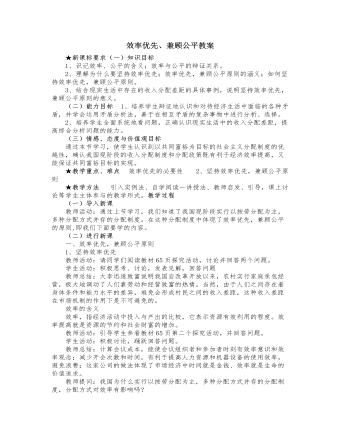
人教版高中政治必修1效率优先、兼顾公平教案
教师活动:引导学生阅读教材67页,回答:什么是效率优先,兼顾公平?如何贯彻此原则?学生活动:阅读课本,认真总结,发表见解教师点评:效率优先,实质是发展生产力优先,分配制度和分配政策要以促进生产力的发展和经济效益的提高为首要目标;兼顾公平,是指社会要将收入差距控制在合理的范围内,使分配的结果能促使人们奋进,社会具有生机喝活力。坚持效率优先、兼顾公平,首先,要允许和鼓励一部分地区和个人通过诚实劳动和合法经营先富起来,先富带后富,最终达到共同富裕。其次,既要反对平均主义,又要防止收入差距悬殊;既要落实分配政策,又要提倡奉献精神。再次,必须正确处理初次分配注重效率与再分配注重公平的关系。初次分配注重效率有利于充分调动人们的积极性。在再分配中,要加强政府对收入分配的调节,调节过高收入,取缔非法收入,提高低收入者的收入水平,通过完善社会保障制度等,把收入差距控制在一定范围之内。
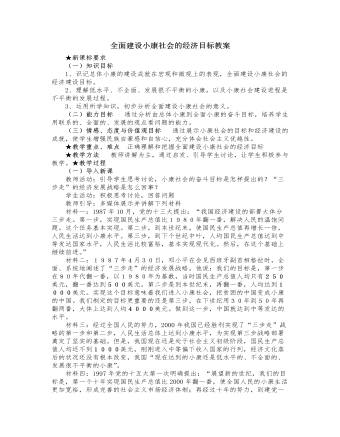
人教版高中政治必修1全面建设小康社会的经济目标教案
3、城镇人口的比重大幅度提高,工农差别、城乡差别、地区差别扩大的趋势逐步扭转请同学们阅读下面材料,结合刚才列举的实例,思考它说明什么问题?2000年我国农村小康总体实现程度在93%左右,城乡收入差距在3:1以上。1999年西部地区小康实现程度为84.18%,中部和东部地区为93.18%、97.86%,人均GDP最高的上海市突破4000美元,最低的贵州省只有300多美元。4、社会保障体系比较健全,社会就业比较充分,家庭财产普遍提高,人民过上更加富足的生活教师活动:请同学们阅读教材102页虚框内材料,思考所提问题学生活动:积极思考,讨论发言。教师总结:说明我国的社会保障体系逐步完善,但是城镇居民保障水平较高,农村社会保障水平还比较低。这与我国的国情是不相适应的,因此,本世纪初20年,要不断健全、完善社会保障体系,集中力量发展经济,降低失业率,提高城乡居民文化教育娱乐等消费比例,让人民的吃穿住行达到更高水平的小康。三、小康社会的建设特点和要求
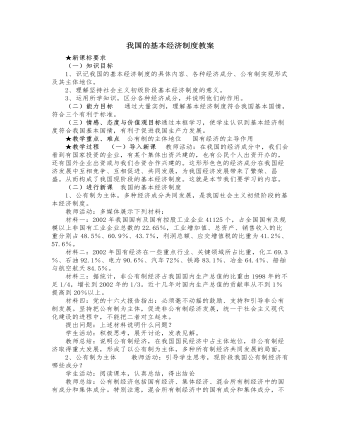
人教版高中政治必修1我国的基本经济制度教案
(3)外资经济 教师活动:外资经济是指外国投资者和港澳台投资者根据我国法律法规,在我国大陆设立的独资企业以及中外合资企业、中外合作企业中的外商投资部分。他有利于引进外资和先进技术,学习境外先进管理经验,有利于扩大就业、扩大出口,增加财政收入。 提醒学生注意中外合资企业、中外合作企业中的外商投资部分,不是指中外合资企业、中外合作企业全部资产。并简略介绍中外合资企业与中外合作企业的区别。(4)非公有制经济的地位 是社会主义市场经济的重要组成部分。教师点拨:请同学们注意比较,非公有制经济的地位与前面集体经济的地位有什么不同?学生活动:积极思考,回答问题教师点拨:集体经济的地位,是社会主义公有制经济的重要组成部分。社会主义公有制经济与社会主义市场经济这两个说法是不同的。(简单了解即可)4、为什么坚持以公有制为主体,多种所有制经济共同发展
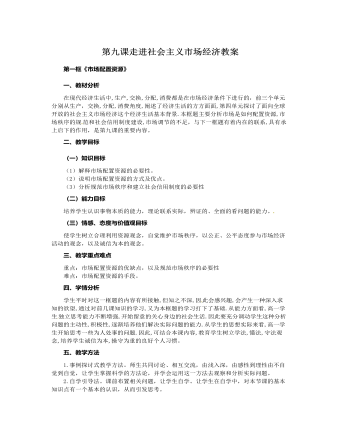
人教版高中政治必修1第九课走进社会主义市场经济教案
法律手段:制定和运用经济法规,包括经济立法、经济司法活动等行政手段:采取强制性的行政命令、指示、规定等运用举例:我国一些地区遭遇突如其来的“禽流感”,禽类养殖户损失惨重。国家采取了对疫区封锁,对疫区的养殖户进行经济补贴,以及国家出资统一对疫区进行消毒等措施进行防治,并规定任何人不得将家禽带出疫区,违者追究法律责任。请结合材料说明在防治“禽流感”、发展禽类养殖的过程中,我国政府分别采取了哪些措施教师分析:对疫区养殖户进行经济补贴体现经济手段;对违反规定者追究法律责任,体现法律手段;对疫区进行封锁体现行政手段。(四)反思总结,当堂检测。教师组织学生反思本节课的主要内容(参照板书),进行总结。设计意图:对本节课的内容进行小结,学生的概括过程也是检验学生对本节课理解程度的过程。再次明确学生是学习的主体,并能够发现,问题解决问题。

人教版高中政治必修1第十一课 经济全球化与对外开放教案
材料说明了什么?探究二:材料分析:2005年12月13日至18日,WTO第六次部长级会议在香港召开。会议经过谈判通过了《部长宣言》,规定发达成员和部分发展中成员2008年前向最不发达国家所有产品提供免关税、免配额的市场准入;发达成员2006年取消棉花的出口补贴, 2013年年底前取消所有形式农产品出口补贴。材料体现了世界贸易组织在国际经济贸易领域中发挥哪些作用?探究三:P97:A、这些图示,反映出我国利用外资哪些特点?。B、能为我国提高外资利用水平提出些建议吗?探究四:材料展示:我国是人口众多的发展中大国,全国居民每天消费总额达到37亿元。每天消费粮食75万吨,相当于一个县级商品粮基地的全年产量;每天消耗猪肉6万吨,食油1万吨,糖1.6万吨,鲜蛋1.8万吨。每天购买杂志600多万册,报纸5000多万份,需要400量中型载货汽车才能装载。
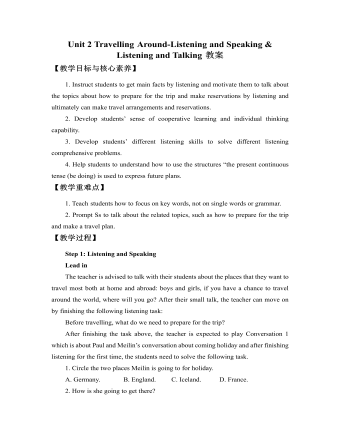
新人教版高中英语必修1Unit 2 Travelling Around-Listening and Speaking & Listening and Talking教案
【教学目标与核心素养】1. Instruct students to get main facts by listening and motivate them to talk about the topics about how to prepare for the trip and make reservations by listening and ultimately can make travel arrangements and reservations. 2. Develop students’ sense of cooperative learning and individual thinking capability. 3. Develop students’ different listening skills to solve different listening comprehensive problems.4. Help students to understand how to use the structures “the present continuous tense (be doing) is used to express future plans.【教学重难点】1. Teach students how to focus on key words, not on single words or grammar.2. Prompt Ss to talk about the related topics, such as how to prepare for the trip and make a travel plan.【教学过程】Step 1: Listening and SpeakingLead inThe teacher is advised to talk with their students about the places that they want to travel most both at home and abroad: boys and girls, if you have a chance to travel around the world, where will you go? After their small talk, the teacher can move on by finishing the following listening task:Before travelling, what do we need to prepare for the trip?
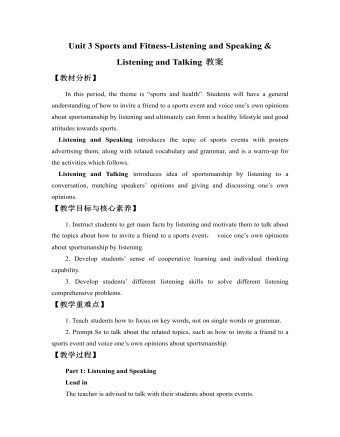
新人教版高中英语必修1Unit 3 Sports and Fitness-Listening and Speaking & Listening and Talking教案
Finally, after finishing the task above, the teacher is expected to instruct students to work in groups to finish the following project:Speaking ProjectWhat event or activity would you like to invite your friend to? Make a conversation with a partner.Ski Race: Zhangjiakou, a beautiful city in northern China, will host the Youth Ski Race in December.Track Meet: a great event for track –and –field lovers on 26 October.Gym Class: come and work out at a gym! You can make it.Part 2: Listening and Talking:The teacher is advised to talk with their new students about the related topic: Boys and girls , what do you think of sportsmanship? Let’s listen and find out:Play the listening and match each opinion with the right speaker. Who do you agree with? Why?Cao Jing _____________ Lily _____________ Max _____________A. An athlete should do his/her best to win.B. The girl should stop and help the other girl. Good sportsmanship is more important than wining!C. An athlete should think about honor and his/her fans if he/she is competing for his/her country.Listen again and circle the expressions that you hear in the conversation.
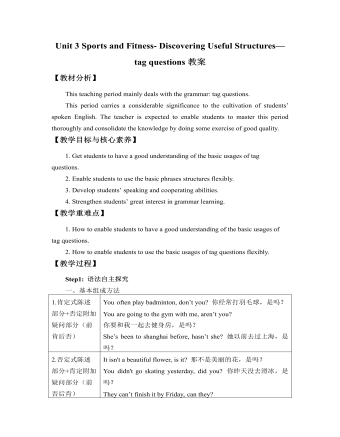
新人教版高中英语必修1Unit 3 Sports and Fitness- Discovering Useful Structures—tag questions教案
【教材分析】This teaching period mainly deals with the grammar: tag questions.This period carries a considerable significance to the cultivation of students’ spoken English. The teacher is expected to enable students to master this period thoroughly and consolidate the knowledge by doing some exercise of good quality.【教学目标与核心素养】1. Get students to have a good understanding of the basic usages of tag questions.2. Enable students to use the basic phrases structures flexibly.3. Develop students’ speaking and cooperating abilities.4. Strengthen students’ great interest in grammar learning.【教学重难点】1. How to enable students to have a good understanding of the basic usages of tag questions.2. How to enable students to use the basic usages of tag questions flexibly.【教学过程】Step1: 语法自主探究一、基本组成方法1.肯定式陈述部分+否定附加疑问部分(前肯后否) You often play badminton, don’t you? 你经常打羽毛球,是吗?You are going to the gym with me, aren’t you?你要和我一起去健身房,是吗?She’s been to shanghai before, hasn’t she? 她以前去过上海,是吗?2.否定式陈述部分+肯定附加疑问部分(前否后肯) It isn't a beautiful flower, is it? 那不是美丽的花,是吗?You didn't go skating yesterday, did you? 你昨天没去滑冰,是吗?They can’t finish it by Friday, can they?他们不能在星期五之前完成,是吗?

新人教版高中英语必修3Unit 1 Festivals and celebrations-Discovering Useful Structure教学设计
4.That was an experience that frightened everyone. →That was _____________________. 答案:1. taking 2. being discussed 3. in the reading room 4. a frightening experienceStep 6 The meaning and function of V-ing as the predicative动词-ing形式作表语,它通常位于系动词后面,用以说明主语“是什么”或“怎么样”一种表示主语的特质、特征和状态, 其作用相当于形容词; 另一种具体说明主语的内容, 即主语等同于表语, 两者可互换。The music they are playing sounds so exciting. 他们演奏的音乐听起来令人激动。The result is disappointing. 结果令人失望。Our job is playing all kinds of music. 我们的工作就是演奏各种音乐。Seeing is believing. 眼见为实。Step 7 Practice1. It is ________(amaze) that the boy is able to solve the problem so quickly.2. Buying a car is simply _______(waste) money. 3. Please stop making the noise—it’s getting ________(annoy). 4. complete the passage with the appropriate -ing form.La Tomatina is a festival that takes place in the Spanish town Bunol every August. I think many food festivals are __________ because people are just eating. however, this festival is _________ because people don't actually eat the tomatoes. Instead, they throw them at each other! the number of people ________ part in this tomato fight, can reach up to 20,000, and it is a very __________ fight that lasts for a whole hour. The _______ thing is how clean Bunol is after the tomatoes are washed away after the fight. this is because the juice form tomatoes is really good for making surfaces clean!答案:1. amazing 2. wasting 3. annoying4. boring interesting taking exciting amazing

新人教版高中英语必修3Unit 1 Festivals and Celebrations-Reading and Thinking教学设计
The topic of this part is “Discover the reasons for festivals and celebrations.The Listening & Speaking & Talking part aims at talking about the experiences and feelings or emotions about the festivals and celebrations. This section aims at detecting the reason why the people celebrate the festivals, the time, the places, the types and the way of celebrations. It also explains why some traditions in the old celebrations are disappearing, like the firecrackers in the big cities and some new things are appearing like the prosperity of business or commerce. 1. Students can talk about what festivals they know and the reasons and the way of celebrating them.2. Students should learn the reading skills such as the headline and get the topic sentences, the structures of articles.3. Students can understand the past, the present situation of some festival around the world and why there are some changes about them. 4. Students can have the international awareness about the festivals.1. Students should learn the reading skills such as the headline and get the topic sentences, the structures of articles.2. Students can understand the past, the present situation of some festival around the world and why there are some changes about them.Step 1 Lead in---Small talkWhat festival do you like best ? Why ?I like the Spring Festivals because I can set off the fireworks, receive the lucky money and enjoy the Gala with my families.Step 2 Before reading---Pair workWhy do people celebrate different festivals ?The Spring Festivals is to celebrate the end of winter and the coming of spring and new life.The Mid-autumn Day is to celebrate the harvest and admire the moon.

新人教版高中英语必修3Unit 1 Festivals and Celebrations-Listening &Speaking&Talking教学设计
The theme of this section is “Talk about festival activities and festival experiences”.Festival and holiday is a relaxing and interesting topic for students. This part talks about the topic from the daily life of students’. In the part A ---Listening and Speaking, there are three conversations among different speakers from three countries(Japan, Rio and China), where the speakers are participating in or going to participate in the festivals and celebrations. So listening for the relationship among them is a fundamental task. Actually, with the globalization and more international communication, it is normal for Chinese or foreigners to witness different festivals and celebrations in or out of China. In the Conversation 1, a foreign reporter is interviewing a Japanese young girl who just had participated in the ceremony of the Coming-of-Age Day on the street and asking her feeling about the ceremony and the afterwards activities. Conversation 2, Chinese girl Li Mei is witnessing the Rio Carnival for the first time, and her friend Carla gives her some advice on the costumes which enables her to match with the carnival to have a good time. Conversation 3, a Chinese guide is showing a group of foreign visitors around the Lantern Festival and introducing the customs of the festival to them. The three conversations have a strong vitality and insert the festival and cultural elements from different countries. So perceiving the festivals and cultures from different countries is the second task. At the same time, the scripts also insert the targeted grammar --- v-ing as attributive and predicative, which students can perceive and experience in a real context and make a road for the further study. That is the third task. In the Part B--- Listening and Talking, the theme is “Talk about festival experience”, which is the common topic in our daily conversations. During the conversation, Song Lin, a Chinese student, asked Canadian friend Max about how to spend Christmas. In the conversation, Song Lin talked about experience and the feelings during the Chinese Spring Festival, during which there are not only some enjoyable things but some unpleasant things. After the listening, perhaps students find there are some similarities between Christmas and the Chinese Spring Festival as there are some differences in the origins and celebrations. For example, people always visit friends and relatives, decorate their houses, have a big dinner together, chat and give presents to each other.

新人教版高中英语必修3Unit 1 Festivals and Celebrations-Reading for writing教学设计二
Step 3 Analyzing article structureActivity 31. Teachers raise questions to guide students to analyze the chapter structure of this diary and think about how to describe the festival experience. (1)What should be included in the opening/body/closing paragraph(s)?(2)How did the writer arrange his/her ideas?(3)What kind of interesting details did the writer describe?(4)How did the writer describe his/her feelings/emotions during the event?2. Students read and compare the three sentence patterns in activity 2. Try to rewrite the first paragraph of the diary with these three sentence patterns. After that, students exchange corrections with their partners. Such as:●This was my first time spending three days experiencing the Naadam Festival in China’s Inner Mongolia Autonomous Region and it was an enjoyable and exciting experience. ●I'll never forget my experience at the Naadam Festival because it was my first time to watch the exciting Mongolian games of horse racing, wrestling, and archery so closely. ●I'll always remember my first experience at the Naadam Festival in China’s Inner Mongolia Autonomous Region because it was so amazing to spend three days witnessing a grand Mongolian ceremony. Step 4 Accumulation of statementsActivity 41. Ask the students to read the diary again. Look for sentences that express feelings and emotions, especially those with the -ing form and the past participle. Such as:● …horse racing, wrestling, and archery, which are all so exciting to watch. ● some amazing performances● I was surprised to see…● I was a little worried about. . . ● feeling really tiredOther emotional statements:●I absolutely enjoyed the archery, too, but the horse races were my favourite part. ●I'm finally back home now, feeling really tired, but celebrating Naadam with my friend was totally worth it. ●He invited me back for the winter to stay in a traditional Mongolian tent and cat hot pot. I can’t wait!2. In addition to the use of the -ing form and the past participle, the teacher should guide the students in the appreciation of these statements, ask them to memorize them, and encourage them to use them reasonably in writing practice.